How To Make A Csv File In Excel
How to catechumen (open or import) CSV file to Excel
The tutorial explains how to apace catechumen CSV files to Excel in any version, from 365 to 2007, avoiding typical issues.
Generally, at that place are two ways to transfer a CSV file to Excel: past opening it or importing equally external data. This commodity provides the detailed guidance on both methods and points out the strengths and limitations of each. Nosotros will as well red-flag possible pitfalls and advise the most constructive solutions.
Convert CSV file to Excel by opening it
To bring information from a CSV file to Excel, you tin can open it directly from an Excel workbook or via Windows Explorer. Whichever method you choose, delight proceed in mind that:
- Opening a CSV document in Excel does not change the file format to .xlsx or .xls. The file will retain the original .csv extension.
- The files are express to 1,048,576 rows and 16,384 columns.
How to open CSV file in Excel
A comma separated values file created in another program tin nevertheless be opened in Excel by using the standard Open up command.
- In your Excel, caput over to theFile tab and clickOpen, or press the Ctrl + O shortcut.
- In the Open dialog box, selectText Files (*.prn;*.txt;*.csv) from the drop-down listing in the lower right corner.

- Scan for the CSV document, and so double-click it to open.
A comma separated values file (.csv) volition be opened in a new workbook straight abroad.
For a text file (.txt), Excel will outset theImport Text Wizard. See Importing CSV to Excel for full details.
How to open CSV file from Windows Explorer
The fastest manner to open a .csv file in Excel is to double click information technology in Windows Explorer. This will immediately open your file in a new workbook.
Still, this method merely works only if Microsoft Excel is set as thedefault app for .csv files. In this example, a familiar dark-green Excel'south icon![]() appears next to .csv documents in Windows Explorer.
appears next to .csv documents in Windows Explorer.
If your CSV files are set to open with another default app, then correct-click the file, and cull Open up with… >Excel.
To set Excel as the default program for CVS files, here are the steps to perform:
- Right-click whatsoever .csv file in Windows Explorer, and and then selectOpen up with… >Cull another app from the context menu.
- Under Other options, clickExcel, check off the Always utilize this app to open .csv files box, and clickOK.

Catechumen CSV to Excel by importing it
Using this method, you tin can import data from a .csv file into an existing or a new Excel worksheet. Unlike the previous technique, it not just opens the file in Excel simply changes the .csv format to .xlsx (Excel 2007 and higher) or .xls (Excel 2003 and lower).
Importing tin exist done in ii ways:
- Past using Text Import Wizard (in all versions)
- By creating a Power Query connectedness (in Excel 2016 - Excel 365)
How to import CSV into Excel with Text Import Wizard
First off, it should exist noted that the Text Import Wizard is a legacy feature, and beginning with Excel 2016 information technology is moved from the ribbon to Excel Options.
If the Text Import Sorcerer is not available in your Excel version, you lot take these two options:
- Enable From Text (Legacy) feature.
- Get Excel to launch theImport Text Wizard automatically. For this, change the file extension from .csv to .txt, open the text file from Excel, and then follow the steps of the wizard described below.
To import a CSV file to Excel, this is what yous need to do:
- In Excel 2013 and earlier, go to theInformation tab > Get External Data group, and clickFrom Text.

In Excel 2016 and subsequently, go to the Data tab > Get & Transform Information group, and click Get Data > Legacy Wizards > From Text (Legacy).
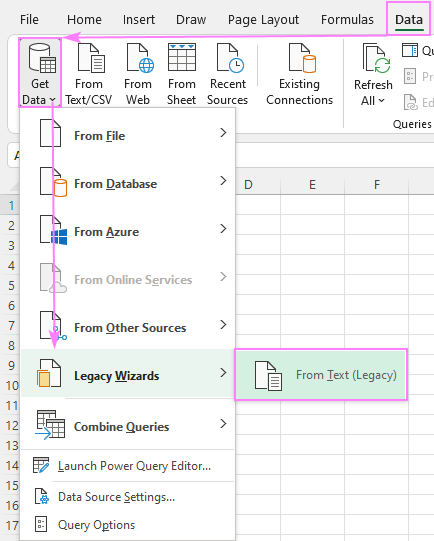
Annotation. If the From Text wizard is non there, brand sure you lot have information technology enabled. If Legacy Wizards is still grayed out, select an empty prison cell or open up a blank worksheet and try again.
- In theImport Text File dialog box, browse for the .csv file you want to import, select it and click theImport button (or simply double-click the file).
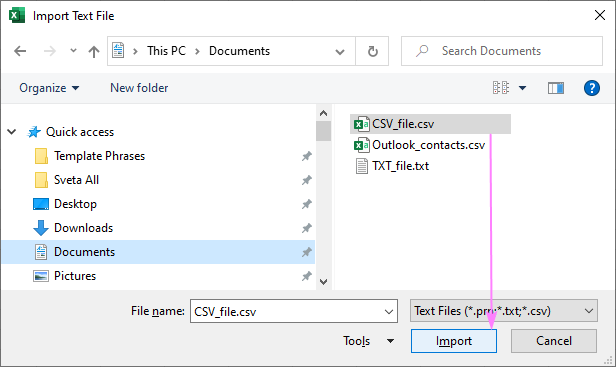
- TheText Import Wizard will start, and you follow its steps. Kickoff, you choose:
- TheDelimited file blazon
- The row number to start import at (ordinarily, row 1)
- Whether your information has headers
The preview window in the lower part of the wizard shows a few first entries from your CSV file.
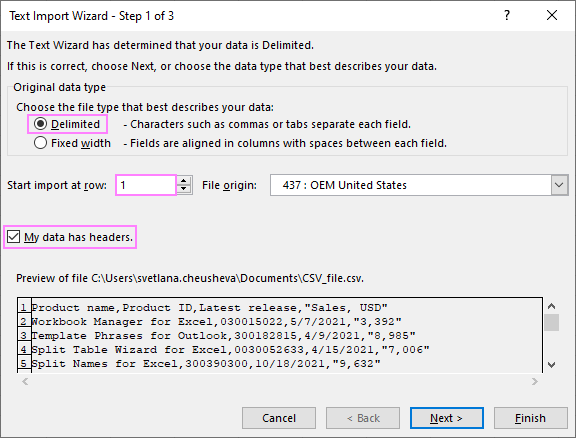
- Cull the delimiter and text qualifier.
Delimiter is the character that separates values in your file. Every bit CSV is a comma separated values file, obviously you select Comma. For a TXT file, you'd typically select Tab.
Text qualifier is the grapheme that encloses the values in an imported file. All text between two qualifier characters will exist imported as one value, even if the text contains the specified delimiter.
Generally, y'all choose the double quote symbol (") as text qualifier. To bank check this, you can click Dorsum and see which character encloses the values in the preview of your CSV file.
In our instance, all numbers with a thousands separator (which is as well a comma) are wrapped in double quotes like "iii,392", meaning they will exist imported in ane cell. Without specifying the double quote sign equally the text qualifier, the numbers earlier and after a thousands separator would go into two adjacent columns.
To make sure your data will be imported as intended, look carefully at theData preview before clicking Adjacent.
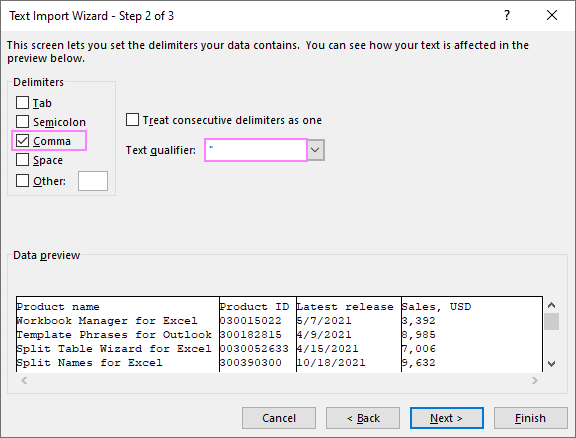
Tips and notes:
- If more than one sequent delimiter is present in your CSV file, so select theTreat sequent delimiters equally 1 pick to prevent empty cells.
- If the preview shows all data in one column, that means a wrong delimiter is selected. Change the delimiter, so that the values are displayed in separate columns.
- Define data format. The default is General - it converts numeric values to numbers, engagement and fourth dimension values to dates, and all remaining data types to text.
To set another format for a specific column, click anywhere within it in the Data Preview, and and then cull ane of the options nether Column data format:
- To keep leading zeros, choose the Text format.
- To correctly display dates, cull the Engagement format, and and then choice an appropriate format in the drib-down box.
When you are happy with the Data preview, click theFinish button.

- Choose whether to import data to an existing worksheet or a new one, and clickOK.
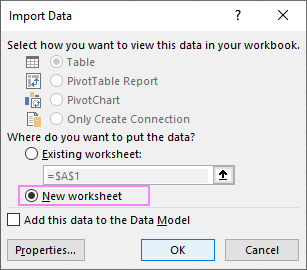
Tips and notes:
- To configure some advanced options such as refresh control, layout and formatting, clickProperties… in the higher up dialog box.
- If some imported information are displayed incorrectly, you can modify the format with the help of Excel's Format Cells feature.
How to enable Text Import Wizard in Excel 2016 - Excel 365
To actuate the Text Import Wizard in modern versions of Excel, this is what you need to do:
- Click the File tab, and so click Options > Data.
- UnderEvidence legacy data import wizards, selectFrom Text (Legacy), and click OK.
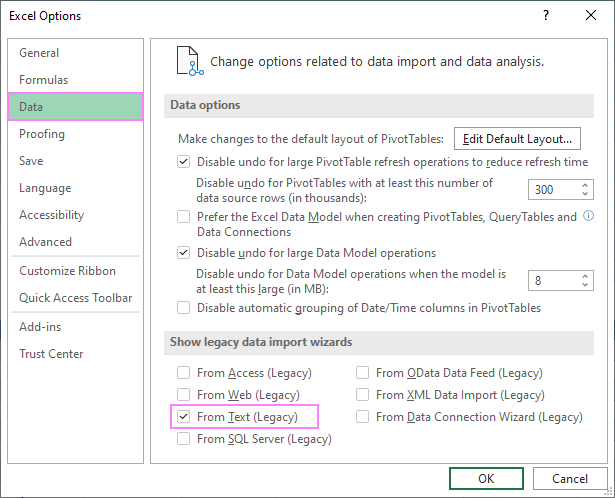
Once enabled, the wizard will announced on the Data tab, in the Get & Transform Data group, under Get Data > Legacy Wizards.
How to transfer CSV to Excel by connecting to it
In Excel 365, Excel 2021, Excel 2019 and Excel 2016, you tin can import data from a text file past connecting to it with the help of Power Query. Here's how:
- On the Data tab, in the Get & Transform Data group, click From Text/CSV.

- In the Import Data dialog box, select the text file of interest, and click Import.

- In the preview dialog box, the post-obit options are bachelor to y'all:
- Delimiter. Choice the character that separates values in your text file.
- Information Blazon Detection. You can let Excel automatically determine data type for each column based on the starting time 200 rows (default) or entire dataset. Or you tin choose not to detect information types and have the data imported in the original Text format.
- Transform Data. Loads the data to the Power Query Editor, and then you can edit information technology before transferring to Excel. Make utilize of this feature to set the desired format for particular columns.
- Load. Controls where to import the data. To go the csv file imported to a new worksheet, select Load. To transfer the data to an existing or new sheet in the form of a table, PivotTable/PivotChart, or only create a connection, choose Load to.

Clicking the Load button will import the CSV data in the table format like this one:

The imported table is linked to the original CSV document, and yous tin update information technology anytime by refreshing the query (Table Design tab > Refresh).
Tips and notes:
- To change the table to a normal range, right-click any cell, so click Table > Catechumen to Range. This will permanently remove the query from the sheet and disconnect the imported data from the original file.
- If values in a certain cavalcade are imported in a wrong format, y'all can effort fixing it yourself by converting text to number or text to engagement.
Converting CSV to Excel: opening vs. importing
When Microsoft Excel opens a .csv file, it uses your default data format settings to understand how exactly to display each column of text data. This works fine in well-nigh situations.
If your text file has specific values and you want to control how to display them in Excel, then do importing rather than opening. Hither are a few typical use cases:
- The CSV file uses unlike delimiters.
- The CSV file contains different date formats.
- Some numbers take leading zeroes that should be kept.
- You want to see a preview of how your CSV data will be converted into Excel.
- You are looking for more than flexibility in general.
How to save CSV file in Excel
Whichever conversion method you used, you tin can save the resulting file similar yous unremarkably would.
- In your Excel worksheet, click File > Save equally.
- Scan for the folder where y'all want to relieve the file.
- To save as an Excel file, select Excel Workbook (*.xlsx) from the Save as blazon drop-down card. To salvage as a comma-separated file, select CSV (Comma delimited) or CSV UTF-eight.
- Click Salve.

How to open multiple CSV files in Excel at once
Equally y'all probably know, Microsoft Excel allows opening several workbooks at a time using the standard Open up command. This as well works for CSV files.
To open multiple CSV files in Excel, here are the steps for you lot to follow:
- In your Excel, click File > Open or press the Ctrl + O keys together.
- Click the Browse push and navigate to the source binder.
- In the driblet-downward list adjacent to the File name box, select Text Files (*.prn, *.txt, *.csv).
- Select your text files:
- To selectside by side files, click the 1st file, hold downward the Shift key, and and so click the last file. Both of the clicked files besides every bit all the files between them will get selected.
- To select non-adjacent files, hold down theCtrl key and click each private file you desire to open.
- With multiple files selected, click theOpen button.

In Windows Explorer, y'all can right-click the selected files and pick Open from the context bill of fare.
This method is straightforward and quick, and we could call it perfect but for ane small thing - it opens each CSV file equally a carve up workbook. In practise, switching back and forth between several Excel files may be quite inconvenient and burdensome. Instead, you can have all files imported into the same workbook - the detailed instructions are here: How to merge multiple CSV files into one Excel workbook.
Hopefully, now you are able to convert whatever CSV files to Excel with ease. And thank you for your patience everyone who has read this tutorial to the finish :)
You may as well be interested in
95 comments to "How to convert (open or import) CSV file to Excel"
Post a comment
How To Make A Csv File In Excel,
Source: https://www.ablebits.com/office-addins-blog/convert-csv-excel/
Posted by: herrickpalle1950.blogspot.com



0 Response to "How To Make A Csv File In Excel"
Post a Comment